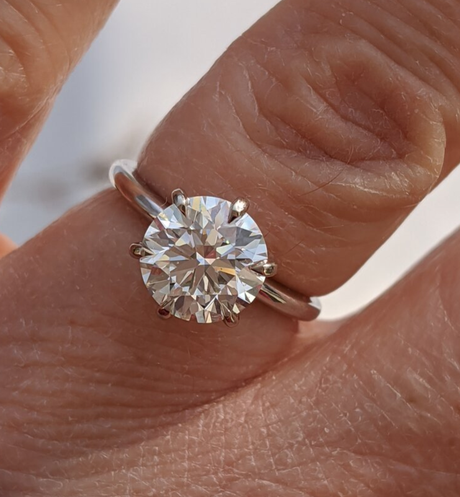Let’s Get Practical
Are FL and IF diamonds always eye-clean?
Absolutely. Any clarity above VS2 is relatively eye clean and the FL and IF grades are four levels of scrutiny higher. Any flawless or internally flawless diamond will be absolutely eye clean by the definition below.
The only characteristics permitted for flawless and internally flawless diamonds include discrete extra facets which cannot be seen from the top, an area of natural skin which is entirely confined to the girdle, and internal graining, which is completely transparent, not white, colored, or reflective, and cannot be seen from the top.
There is no laboratory definition for eye clean, but a PriceScope survey of gemologists resulted in this consensus:

Photo Courtesy of PS Member Soxfan
Eye-clean = No inclusions visible to the unaided eye when viewed from the face up position in daylight equivalent or fluorescent lighting from approximately 6 – 12 inches from the eye using 20/20 vision.
Real World Information
A Flawless diamond will not sparkle better than a diamond with lower clarity. A diamond’s observable brightness, fire, sparkle, and contrast are all attributable to its cut quality. A diamond’s optical properties are not influenced by inclusions and blemishes, except in the very lowest grading category Included: (I1-I2-I3): Those three grades are reserved specifically for diamonds with inclusions numerous or severe enough to impact light transmission and/or durability.
Reality Check
A diamond’s clarity grade is established at 10X magnification. Examination at higher levels of magnification may reveal natural clarity characteristics which do not appear at 10X. Such characteristics are permitted in “flawless” diamonds since they were not a technical consideration at 10X magnification.
D Flawless Prestige
FL or IF clarity, when paired with D color and a top cut grade (for round brilliants) represents the highest pedigree in the diamond world. This “D Flawless” (or IF) pedigree becomes even more prestigious when the diamond type is confirmed to be Type IIa, the most chemically pure in nature.
Collection Quality
A flawless or internally flawless diamond, when paired with D, E, or F color and a top cut grade, are considered to be collection quality. Such diamonds, with the purest natural color and clarity grades, have typically held their value best over time and have special status in the eyes of many diamond professionals, collectors, enthusiasts, and auction houses.













